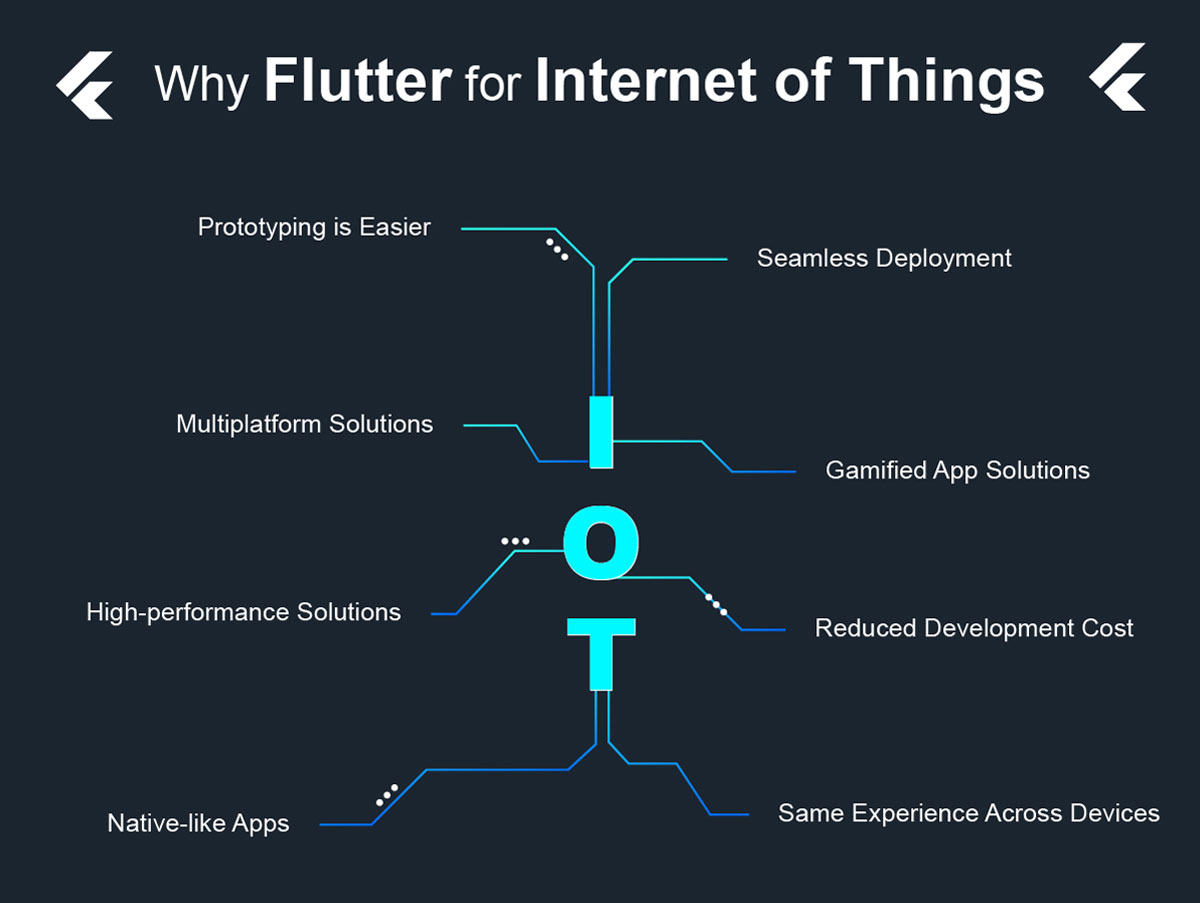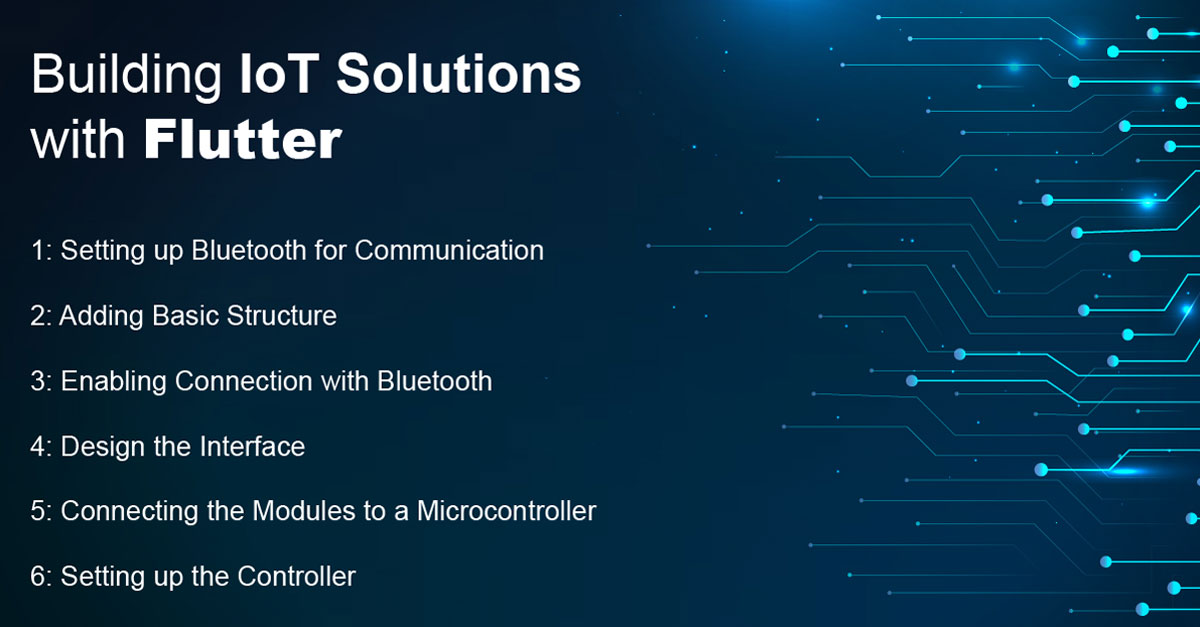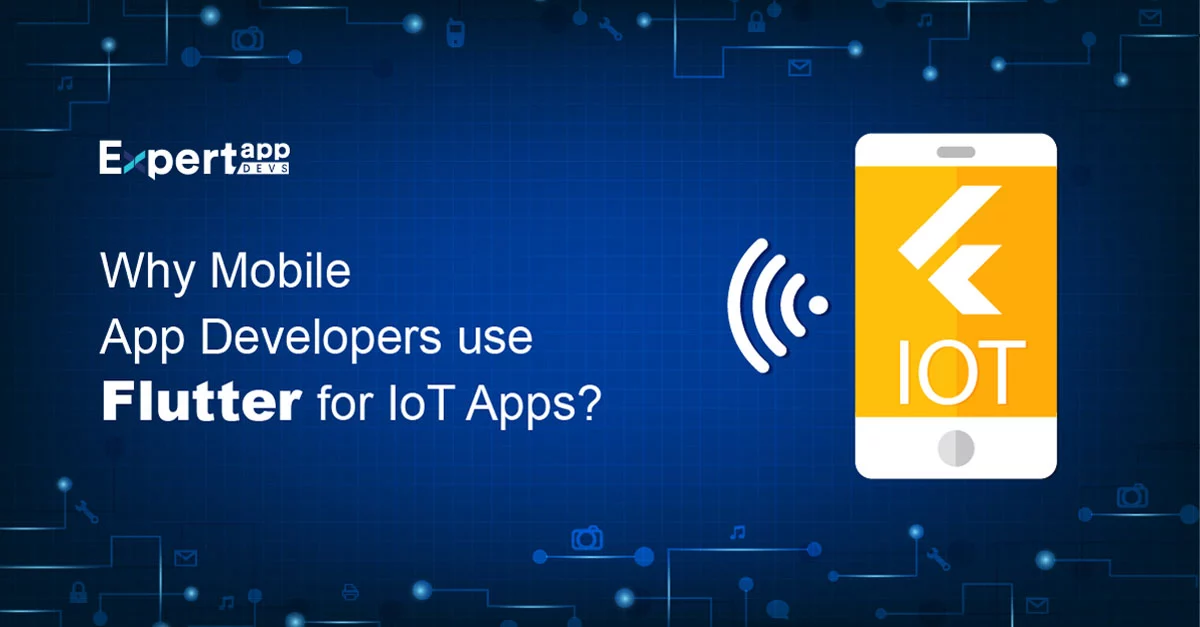Top Reasons Why Developers Use Flutter for IoT Apps
Technology has reimagined lives. It has redefined our communication with machines; it has also led to a transformation in how machines interact. For example, today, you can connect and operate your AC with a mobile phone (an example of a machine interacting with another machine). This is because the Internet allows two IP addresses to have conversations.
IoT-enabled mobile apps are in the here and now. It will keep growing in the future as connected devices grow exponentially in numbers. A large number of businesses are catering to this need.
There are two things that you need to answer before you start working on your IoT app:
- Whether to go native or cross-platform with your approach?
- What framework to choose for development?
Considering the raging need to increase your business's visibility and reach, you might want to consider cross-platform. It allows you to grow your customer base on both platforms.
Developers are in love with Flutter for cross-platform. At least 42% of developers will use Flutter for app development in 2022. Over 20k apps have been developed using this technology.
Alibaba, Grab, and Google Pay are some of the top apps that use the Flutter framework. There are many reasons why Flutter is taking the stage for cross-platform development.
- The high performance that comes with Dart Programming language
- The material design that helps render flexible interfaces
- Strong backing from the community
- Google services support
Now most developers consider developing IoT projects using Flutter. It has become the soul of app development for all good reasons.
The IoT Scenario
When we are talking about connected devices, the protagonist of this is hardware. It is the hardware that people buy with the software attached to it. Remember the intelligent bulb you recently purchased? It was the hardware that you created.
As a hardware innovator, you are not only creating the product but also the underlying software. You need to make sure that it is available to people who use iOS and Android. You cannot make them purchase both to use your hardware, can you?
Apart from the mobile app, there are two things you need to consider developing for the IoT project:
The firmware: This is the software product that you need to develop using which the mobile app would connect to the physical product.
The actual product: This is the device or product you will sell in almost all eCommerce stores. It could be your home AC, a desk, or even the bulb we just talked about... Imagine your strategists and the entire team trying to identify how best to create an app with minimal effort and maximum outcome. That's where Flutter comes to your aid.
Why Flutter for IoT?
At this point, after hearing out the need for a solid and robust framework, you may ask why Flutter for IoT applications. We have the reasons ready for you.

#1 Prototyping is Easier
App prototyping is essential to envision your app and accelerate development. With IoT apps, you need to build a proof of concept before getting started. The Flutter framework ensures you release PoC IoT models faster than other frameworks. You will know whether the idea is feasible and can accelerate your time to market.
#2 Multiplatform Solutions
As discussed earlier, you need to release the application on both platforms simultaneously. You can develop a single codebase and use it for all your web and mobile application requirements. It is also an excellent framework to build your first MVP. If you have an approved prototype, you can use this framework to develop the mobile app to share with your end-users.
#3 High-performance Solutions
When talking about IoT mobile app solutions, you are talking about high-speed and load-bearing solutions. These mobile apps need to be able to handle the ever-increasing load continuously. It is essential to build solutions that are capable enough to ensure their performance is not compromised as the load increases. That's why you need a stable and high-performing framework like Flutter.
#4 Native-like Apps
When delivering solutions on iOS and Android, you need to ensure that the end-user doesn't experience friction. This is especially true when you build a software solution for hardware.
You don't want the user to send back the product or offer poor feedback. To make your interface more intuitive and the usability more functional, you should rely on the inherent features of the operating system and device.
Flutter allows you to use the device features and functions to create your app solution, thus making it more native-like.
#5 Seamless Deployment
Imagine if you have to deploy your Android app weeks after you have released your iOS app. Won't it be unfair to your Android customers? It would also lower your credibility to a great extent, considering people want businesses to release apps for both platforms simultaneously.
Additionally, when you are dealing with a connected device solution, this is truer. That's why you should opt for Flutter. It ensures native-like performance across platforms and allows you to deploy simultaneously without delay.
This allows developers to develop, test and deploy applications simultaneously. You can also review changes in real-time across platforms.
#6 Gamified App Solutions
When you are developing an IoT solution, gamification plays a pivotal role. It motivates people to stay rooted in the app by offering rewards. If you want to create a stable app using gamification, you should implement a flutter framework.
It offers a gamified interface with ease and ensures smooth operation and speed.
#7 Reduced Development Cost
For IoT apps, you need to release them on both platforms simultaneously. If you had to hire a development team for both operating systems individually, it would cost you a lot. You need to invest in only a single developer, designer, and tester with the Flutter framework.
This saves you a lot of development time and cost. Your single codebase works across the operating systems, and a Flutter expert is all you need.
#8 Same Experience Across Devices
Your user won't experience friction when operating the IoT solution on Android or iOS or a web application. You can create similar layouts, control, and view for all systems and devices with the material design.
The Flutter solution works on outdated systems and devices too. You create your interfaces using widgets, and these widgets help create complex interfaces.
These widgets and other components are reusable, thus allowing you to design your app quickly and with fewer efforts.
Building IoT Solutions with Flutter
At this point, we will take you through what you need to develop your IoT mobile app, some of the pre-requisites, and how to build a complete solution.
You can connect an electrical device with a mobile app by pairing it with a nearby device. For example, when you pair the device with Bluetooth or WiFi, you can easily connect it with the mobile app.
That's how you develop an IoT solution.

Step #1: Setting up Bluetooth for Communication
You cannot build a Flutter app solution for IoT if you haven't configured it for Bluetooth or WiFi connection.
Note: Flutter doesn't come with in-built support for Bluetooth.
You will need to look for plugins that can help you pair with Bluetooth. Look for third-party Bluetooth APIs that will help you manage the connection properly. You need a plugin that offers smooth communication and convenient integration.
We initially chose Flutter_Blue but participated in several difficult-to-reproduction issues. We ended up switching to flutter_ble_lib. The latter is built on top of RxAndroidBle and RxBluetoothKit, solid and widely deployed native libraries.
Step #2: Adding Basic Structure
You should first add the basic structure to the main—dart file. Make sure to remove all the Flutter demo counter code from the file.
Since we are connecting over Bluetooth for understanding, you need a widget for Bluetooth App Class. You will need to ensure that the widget state keeps evolving during the app lifecycle, as you will use it for different purposes at different times.
Step #3: Enabling Connection with Bluetooth
At this point, you need to connect the device over Bluetooth. It would help if you also made sure that the pairing remains, even after the temporary use, so that you can retrieve it.
This makes sure that the person need not pair the device again to switch it on. At this point, your focus as a developer is to enable the Bluetooth connection for the device.
When developing the app, initialize the essential variables and add the necessary class for Bluetooth pairing retrieval.
You need to put the current Bluetooth state to initiate(). This will determine if the Bluetooth is on/off. You can get the device to send a request to switch it on when out.
enableBluetooth () provides access to Bluetooth
getPairedDevices() helps retrieve a list of all the paired devices
Make sure to define a memory variable so that the device remembers the pairing in case of disconnection.
Step #4: Design the Interface
You need to design the layout for Bluetooth on and off and connect and disconnect. You will need to define the code structure to help you get standard buttons and design for the interface. It should be a simple toggle at the user's end so that they can quickly make the decision.
Step #5: Connecting the Modules to a Microcontroller
You have designed the pairing of the device with Bluetooth. You have integrated the Bluetooth plugin. It is now time to incorporate the device into the software.
You will need hardware components like the microcontroller, jumper wires, switch, and Bluetooth transceiver module. The most popular microcontroller is the Arduino Uno Rev3. It is an electronics controller where you can upload the code.
Step#6: Setting up the Controller
Your last step involves setting up the controller and fitting the logic you developed using Flutter. You will then connect the controller with a web editor. Once your code is on the web editor, you are ready to test the app and deploy it.
Conclusion
Flutter is an excellent framework to develop your next IoT application. Whether you want to create a PoC or an MVP, you can use this framework to check feasibility and gain feedback into the application.
You have to make sure you have chosen the right widgets for interface design and suitable Bluetooth plugins. Once you have the microcontroller, added the logic to it, and enabled the Bluetooth connection, your IoT app is ready for testing in a real environment.
If you are not sure whether your in-house team can build the next IoT solution, get in touch with Expert App Devs to hire dedicated Flutter developer.
 Jignen Pandya
Jignen Pandya





